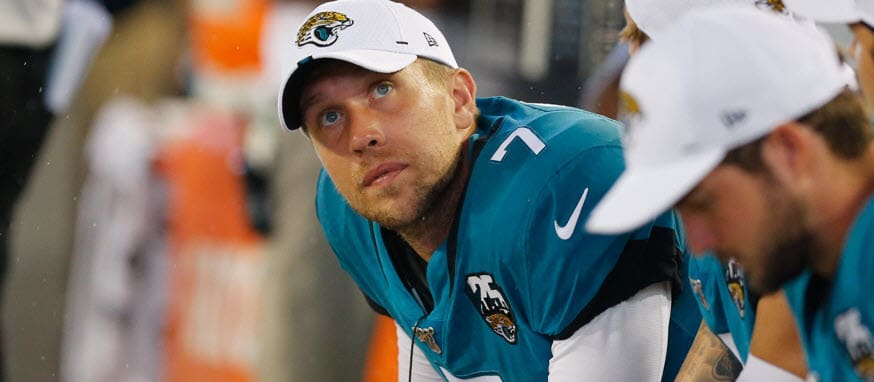This article is part of our Injury Analysis series.
The clavicle (collarbone) is a simple bone, but several players illustrated its importance in Week 1. The collarbone sits between the sternum (breastbone) and the scapula (shoulder blade). Here it serves as a strut between the chest and the shoulder, allowing the arm to be raised overhead. However, its positioning leaves the collarbone vulnerable to injury, making it the most commonly fractured bone in the body.
Jacksonville quarterback Nick Foles learned this firsthand Sunday when he broke his left collarbone in the team's loss to Kansas City. The injury occurred in the first quarter after Foles was driven into the ground by the Chiefs' Chris Jones. The body weight of the lineman compounded the fall, sending a high amount of force through Foles' left arm. The hit applied an axial load through the fragile bone, the perfect mechanism for a clavicle fracture. and the exact situation the NFL attempted to avoid when it implemented new rules in 2018. The rule adjustment forbid defensive players to "[use] all or part of his body weight to land on a quarterback immediately after the ball is thrown." The rule change came on the heels of Pro Bowl quarterbacks Tony Romo and Aaron Rodgers sustaining collarbone fractures in a similar fashion.
Oddly enough, Foles has broken this collarbone before. Back in 2014, Foles suffered the same injury on a near identical play with Texans linebacker Whitney Mercilus applying the hit. Foles avoided surgery back then, but wasn't as lucky this time around. He
The clavicle (collarbone) is a simple bone, but several players illustrated its importance in Week 1. The collarbone sits between the sternum (breastbone) and the scapula (shoulder blade). Here it serves as a strut between the chest and the shoulder, allowing the arm to be raised overhead. However, its positioning leaves the collarbone vulnerable to injury, making it the most commonly fractured bone in the body.
Jacksonville quarterback Nick Foles learned this firsthand Sunday when he broke his left collarbone in the team's loss to Kansas City. The injury occurred in the first quarter after Foles was driven into the ground by the Chiefs' Chris Jones. The body weight of the lineman compounded the fall, sending a high amount of force through Foles' left arm. The hit applied an axial load through the fragile bone, the perfect mechanism for a clavicle fracture. and the exact situation the NFL attempted to avoid when it implemented new rules in 2018. The rule adjustment forbid defensive players to "[use] all or part of his body weight to land on a quarterback immediately after the ball is thrown." The rule change came on the heels of Pro Bowl quarterbacks Tony Romo and Aaron Rodgers sustaining collarbone fractures in a similar fashion.
Oddly enough, Foles has broken this collarbone before. Back in 2014, Foles suffered the same injury on a near identical play with Texans linebacker Whitney Mercilus applying the hit. Foles avoided surgery back then, but wasn't as lucky this time around. He has already undergone the procedure to stabilize the bone and has been placed on the injured reserve. Foles will not be eligible to return until Week 11 after the team completes their Week 10 bye. He will be able to maintain his conditioning while sidelined and, because the injury occurred to his nonthrowing arm, Foles could resume throwing before the bone is completely healed. Rookie Gardner Minshew will take over as the starter for the Jaguars.
Chiefs receiver Tyreek Hill also suffered a collarbone injury in the Week 1 matchup between Kansas City and Jacksonville, though Hill's injury was a bit more complex.
The collarbone forms two joints. The acromioclavicular (AC) joint is formed where the clavicle meets the scapula at process known as the acromion. The sternoclavicular (SC) articulation is formed on the opposite end of the bone where the clavicle meets the sternum. The SC joint allows the clavicle to move in multiple planes, thanks to a well-placed cartilage disc. Injuries to the SC joint can be extremely dangerous and potentially life-threatening . The trachea and multiple major blood vessels are located directly behind the clavicle and can be compromised if the collarbone dislocates backward or posteriorly.
Unfortunately, this is precisely what happened in Jacksonville as Hill suffered a posterior dislocation of the SC joint. While Hill's injury did not disrupt blood vessels or nerves, the medical staffs from both teams responded quickly and sent him to an area hospital where the dislocation was returned to its original positioning.
Determining how long Hill will be sidelined is difficult, as the injury is relatively uncommon. However, there have been a few notable cases that could provide a sliver of insight. An SC sprain infamously ended Brett Favre's record for consecutive starts by a quarterback and ultimately kept him out for two weeks. A better comparison may be receiver Danny Amendola who missed three weeks (four if you include a well-timed bye week) during the 2012 season. Still, the complexity of the injury makes an outright comparison challenging, and more details should emerge in the coming days. The team is hopeful Hill will avoid the IR, but it does appear he will miss multiple weeks.
Turf Burns
Tevin Coleman 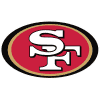 : The 49ers running back core continues to be plagued by the injury bug, with Coleman joining Jerrick McKinnon on the sidelines. Coleman is expected to miss at least one week with a high ankle sprain. High ankle sprains tend to need a longer recovery window than a normal lateral ankle sprain, and it wouldn't be surprising if he sits for Week 3 as well. Matt Breida and Raheem Mostert will man the San Francisco backfield while he recuperates.
: The 49ers running back core continues to be plagued by the injury bug, with Coleman joining Jerrick McKinnon on the sidelines. Coleman is expected to miss at least one week with a high ankle sprain. High ankle sprains tend to need a longer recovery window than a normal lateral ankle sprain, and it wouldn't be surprising if he sits for Week 3 as well. Matt Breida and Raheem Mostert will man the San Francisco backfield while he recuperates.
Derrius Guice : The second-year running back made his NFL debut in Week 1 after missing all of last season with a torn left ACL. Sadly, a new injury in the opposite knee will push back his second game as a pro. Guice suffered what was initially called a sprain but is now being called a meniscus injury following additional testing. The injury could easily be both, as fibers from the medial collateral ligament (MCL) are embedded into the medial meniscus. The team is currently evaluating treatment options, but it sounds like Guice is slated to miss multiple games. The final decision regarding treatment will dictate the exact length of Guice's absence, but he's clearly a risky investment moving forward. Veteran Adrian Peterson could be in line for a decent workload come Sunday.
: The second-year running back made his NFL debut in Week 1 after missing all of last season with a torn left ACL. Sadly, a new injury in the opposite knee will push back his second game as a pro. Guice suffered what was initially called a sprain but is now being called a meniscus injury following additional testing. The injury could easily be both, as fibers from the medial collateral ligament (MCL) are embedded into the medial meniscus. The team is currently evaluating treatment options, but it sounds like Guice is slated to miss multiple games. The final decision regarding treatment will dictate the exact length of Guice's absence, but he's clearly a risky investment moving forward. Veteran Adrian Peterson could be in line for a decent workload come Sunday.
Patrick Mahomes  : The reigning MVP picked up right where he left off last season, throwing for 378 yards and a touchdown against the Jaguars. The numbers are even more impressive when you consider he played most of the game on a sprained ankle. Mahomes is confident he will be in the lineup on Sunday and, barring some unforeseen setback, there is little reason to doubt him.
: The reigning MVP picked up right where he left off last season, throwing for 378 yards and a touchdown against the Jaguars. The numbers are even more impressive when you consider he played most of the game on a sprained ankle. Mahomes is confident he will be in the lineup on Sunday and, barring some unforeseen setback, there is little reason to doubt him.
Baker Mayfield 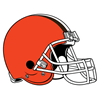 : The Browns endured a disappointing Week 1 that left their starting quarterback sporting a wrap on his throwing hand. X-rays on the hand were negative, and Mayfield downplayed the severity of the injury after the game. However, any injury to the hand could affect his grip on the ball and impact his throwing accuracy. While it doesn't appear as though he will miss time, keep a close eye on his level of participation in the week ahead. Fortunately, the Browns face the Jets on Monday night football, giving Mayfield an extra day of recovery.
: The Browns endured a disappointing Week 1 that left their starting quarterback sporting a wrap on his throwing hand. X-rays on the hand were negative, and Mayfield downplayed the severity of the injury after the game. However, any injury to the hand could affect his grip on the ball and impact his throwing accuracy. While it doesn't appear as though he will miss time, keep a close eye on his level of participation in the week ahead. Fortunately, the Browns face the Jets on Monday night football, giving Mayfield an extra day of recovery.
Joe Mixon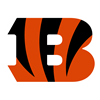 : The Bengals running back injured his ankle on Sunday, but additional testing seems to suggest the injury is a low-grade sprain. He is currently listed as day-to-day, though ankle injuries can be very limiting for running backs. "Normal" sprains involve the ligaments located on the outside of the ankle joint. These structures are placed under high stress when an individual attempts to pivot or make a hard cut. Mixon may be limited throughout the week and will enter Week 2 as a precarious play. Fantasy owners invested in Mixon may want to consider adding Giovani Bernard as an insurance policy.
: The Bengals running back injured his ankle on Sunday, but additional testing seems to suggest the injury is a low-grade sprain. He is currently listed as day-to-day, though ankle injuries can be very limiting for running backs. "Normal" sprains involve the ligaments located on the outside of the ankle joint. These structures are placed under high stress when an individual attempts to pivot or make a hard cut. Mixon may be limited throughout the week and will enter Week 2 as a precarious play. Fantasy owners invested in Mixon may want to consider adding Giovani Bernard as an insurance policy.
Sterling Shepard 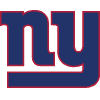 : The Giants receiver was diagnosed with a concussion following his team's loss to the Cowboys. Shepard will need to complete the league's mandated concussion protocol before being cleared to return. Given his history with migraines, consider Shepard questionable at best.
: The Giants receiver was diagnosed with a concussion following his team's loss to the Cowboys. Shepard will need to complete the league's mandated concussion protocol before being cleared to return. Given his history with migraines, consider Shepard questionable at best.

